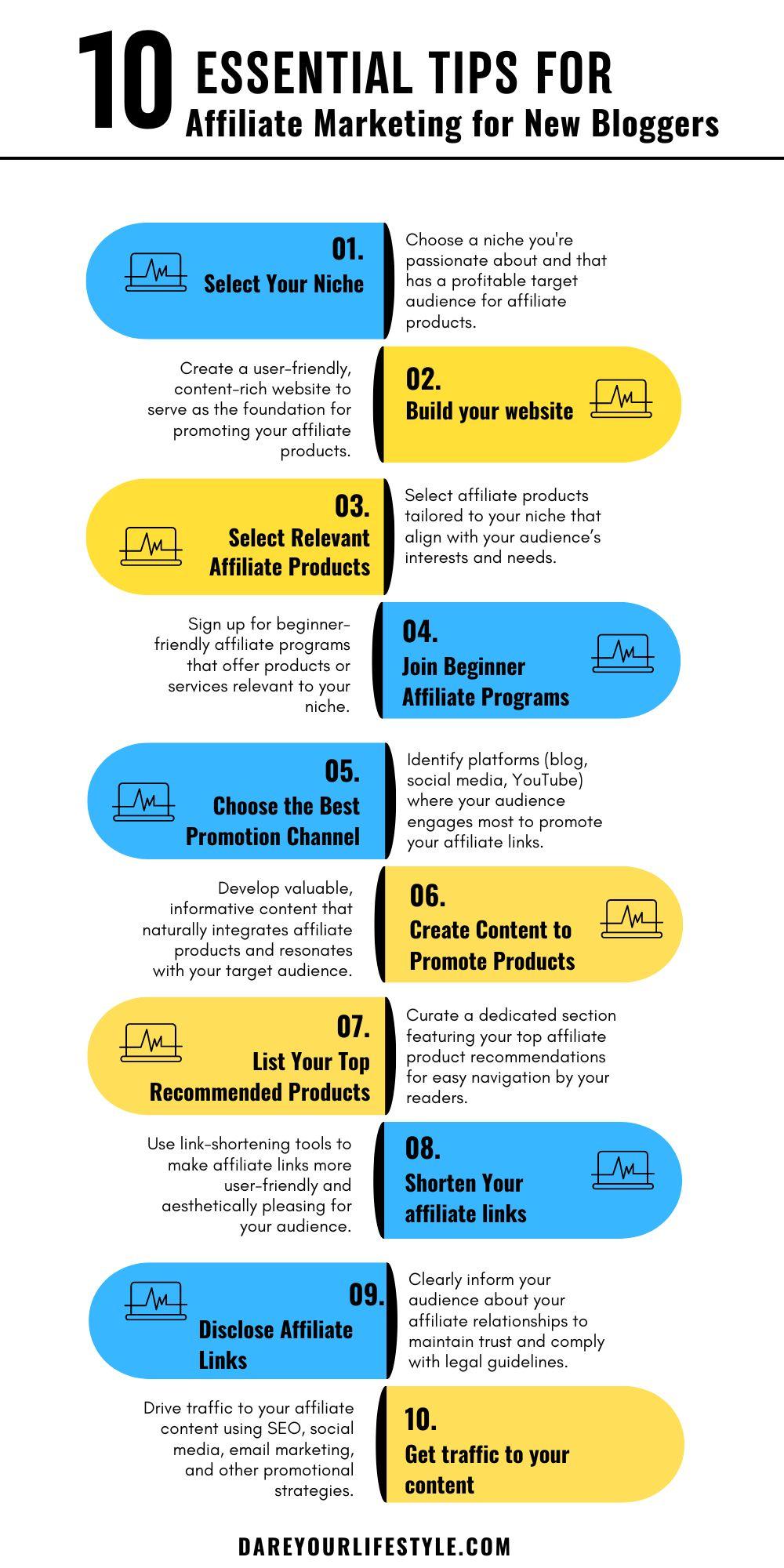Disclaimer: This post may contain affiliate links, meaning we get a small commission if you make a purchase through our link at no extra cost to you. For more information, please visit our Disclaimer Page.
When I kicked off this blog in late 2019, I was set on finding a way to make a living through blogging.
I had a good grasp of the basics, but figuring out the best way to create passive income wasn’t so clear.
After some digging, I found three potential strategies for making money with my blog:
I was utterly clueless, but that changed!!
Table of Contents
Is Affiliate Marketing Easy for Beginners?
So you have decided to explore affiliate marketing as a blogger. Now you might be
Absolutely! the application of it is easy.
But it does take effort on your part
Many beginners worry about complexity, but the basics are simple.
You promote products and earn a commission for sales made through your links
Hence this “Affiliate Marketing for Dummies” guide to share my experience!
Fast forward to 2021, when I decided to go deeper into this blogging thing, I was able to make my first commission of $32.
Yes, $32. Don’t laugh. hear me out.
This made me realize that just as how this $32 is possible , I could make way more.
And I did!!
The great part is that I have learnt a lot along the way.
Now, I’m excited to share those valuable lessons with you in this guide.
So, let’s get started!
What is affiliate marketing?
Are you ready to start earning passive income online through affiliate marketing?
That’s fantastic!
If you’re just diving into this world, you might be asking yourself: What’s the deal with affiliate marketing?
Simply put, affiliate marketing involves promoting other people’s products. When someone buys a product through your referral link, you earn a commission.
There are two primary ways to make money with affiliate marketing:
- Promoting Products: If you don’t have your own product to sell, you can still earn money by sharing products you truly believe in and recommend.
- Starting Your Own Affiliate Program: If you already have a product, you can create an affiliate program that encourages others to promote it for you, rewarding them for their efforts.
Basically, affiliate marketing lets you separate the process of (1) creating a product from (2) selling it.
Most bloggers and content creators kick off their affiliate marketing journey by endorsing existing products. While this saves you from the hassle of product creation, it still requires a significant amount of effort.
Your biggest challenge will be driving enough traffic to your blog to make meaningful sales that translate into a decent income.

Is Affiliate Marketing Worth It in 2024?
Yes! Affiliate marketing is worth it in 2024.
With e-commerce continuing to grow, the opportunities are endless.
Consider these benefits:
- Flexibility: Work from anywhere, anytime.
- Passive income potential: Earn money while you sleep.
- Diverse programs: There’s something for everyone.
Staying updated on trends and best practices will keep you ahead of the game.
Your hard work will definitely pay off!
Breaking Down the Affiliate Marketing Framework: Four Essential Parts
If you’re eager to start making money through affiliate marketing, it’s crucial to understand how the system operates. Let’s break it down into four key components:
1. The Seller (Merchant)
The seller, or merchant, is anyone who offers a product for sale. This could range from a large corporation to a small business or even an individual creator. If you’ve developed your own product, you can create an affiliate program that enables others to promote it on your behalf.
2. The Promoter (Affiliate)
The promoter, or affiliate, takes on the role of marketing the merchant’s product. Their job is to showcase the benefits and value of the product to potential buyers. If someone purchases through the affiliate’s referral link, the affiliate earns a commission.
For instance, I often share tools that have significantly contributed to my blogging success. I’ve compiled these recommendations on my Resources page, making it easier for others to find what they need. When fellow bloggers purchase through my links, I earn a small commission without any extra cost to them.
3. The Affiliate Network
Affiliate networks serve as intermediaries that connect sellers with promoters. They handle the technical aspects of affiliate programs, including tracking sales and ensuring that commissions are paid out correctly.

These networks can manage multiple affiliate programs at once. For example, networks like ClickBank provide access to a vast selection of products that affiliates can promote.
4. The Buyer (Customer)
Customers are the driving force behind affiliate marketing. Without their purchases, no commissions will be made. Therefore, it’s vital for affiliates to recommend products that truly resonate with their audience.
What’s great is that customers usually do not incur any additional costs when buying through an affiliate link. In fact, many merchants offer exclusive deals for those purchasing through their affiliate partners.
Now that you have a solid understanding of the affiliate marketing framework, you’re ready to embark on your journey!
Bringing It All Together: Understanding How Affiliate Marketing Work
Here’s a brief overview of how affiliate marketing operates:
Earning Commissions: The affiliate receives a commission for successfully referring the customer.
Joining an Affiliate Program: The affiliate registers for a merchant’s affiliate program or an affiliate network.
Using Tracking Links: The affiliate receives a unique tracking URL to use when promoting the merchant’s products.
Attracting Customers: The customer visits the affiliate’s website, blog, or social media page.
Clicking the Link: The customer clicks on the affiliate’s tracking link, which directs them to the merchant’s website.
Tracking Cookie Activation: A tracking cookie is placed in the customer’s browser, linking their visit back to the affiliate.
Making a Purchase: The customer completes a purchase from the merchant’s store.
Sale Recognition: The merchant identifies the tracking cookie and attributes the sale to the affiliate who referred the customer.
Affiliate Marketing for Dummies: Your Comprehensive Step-by-Step Blueprint
Are you ready to embark on your affiliate marketing adventure and start raking in your first commissions sooner than you might think?
I’m excited to walk you through each essential step needed to thrive as an affiliate marketer and create income online.
It’s important to pay attention and follow this guide closely. This “Affiliate Marketing for Dummies” resource will provide you with the strategies I’ve successfully implemented, allowing you to start applying them immediately!
This guide is detailed, so don’t hesitate to share it and pin it for later.

1: Select Your Niche
The first step in your affiliate marketing journey is to select a niche that will be the focus of your website or blog.
A niche is essentially a specific market segment. Ideally, you want to choose one with enough demand for affiliate products, ensuring that visitors to your site will convert into buyers.
However, avoid opting for a niche that is too broad. The more specialized your niche, the easier it becomes to connect with an audience that resonates with your message.
Additionally, a well-defined niche can enhance your search engine ranking, leading to organic traffic flowing to your website.
To help you pinpoint the ideal niche, consider these questions:
What ignites your passion?
If you aim to master affiliate marketing and generate income online, you’ll be dedicating significant time to research and content creation. Selecting a niche you truly enjoy will make this process much more enjoyable and fulfilling.
What topic can you discuss endlessly?
If you’re uncertain about what excites you, think about the subjects you love engaging in with others. If you find yourself frequently chatting about a specific topic, that could be the ideal niche for you. You might also want to review your browser history to identify sites you often visit.
Is there potential for monetization in your niche?
While passion is essential, it’s equally important to assess the monetization potential of your niche. After all, you’re eager to earn through affiliate marketing—right?
To reach this goal, you must identify a niche that offers opportunities for commission earnings.
How familiar are you with your chosen niche?
The key to success in affiliate marketing is selecting a niche where you have a solid understanding. You don’t want to endorse products you haven’t personally tested. It’s crucial to ensure that the products you recommend are genuinely beneficial to your audience based on your own experiences.
For more detailed guidance, check out my article on how to find the perfect niche for your blog or website.
What is the Best Niche for Affiliate Marketing in 2024?
In 2024, the best niche for affiliate marketing for dummies will be one that’s trendy and engaging.
Consider these popular niches:
- Health and Wellness:
People are always looking for advice on fitness, nutrition, and mental health. - Personal Finance:
Everyone wants to save or earn more, making budgeting and investment tips highly sought after. - Sustainable Living:
Eco-friendly products and practices are on the rise as consumers become more environmentally conscious. - Tech Gadgets:
The demand for the latest tech trends and gadgets is always growing. - Beauty and Skincare:
This niche is continually evolving, with new products and trends emerging regularly. - Travel:
As travel resumes, tips for destinations, gear, and experiences are in high demand. - Home Improvement and DIY:
With more people focusing on their living spaces, home improvement ideas and DIY projects attract interest. - Pet Care:
Pet owners are always looking for the best products and care tips for their furry friends. - Online Education:
With the growth of e-learning, courses and resources for skill development are popular. - Parenting and Family:
Advice and products for parenting and family life resonate with many audiences.
Pick a niche that resonates with you and aligns with audience needs.
Doing what you love makes all the difference!
2: Build your website
Now that you’re diving into affiliate marketing for dummies, it’s time to set up your blog or website!
Before we proceed, it’s crucial to understand:
To earn money through affiliate marketing, your website must be self-hosted on a web server that gives you the freedom to customize it as you wish.
Self-hosting means you have complete control over your site, allowing you to manage all aspects of it effectively. Most importantly, you will retain ownership of all your website content.
If you opt for a free website platform, you run the risk of having your site shut down without notice, resulting in the loss of your content, traffic, and income—all your hard work could vanish in an instant.
Follow these steps to establish your blog or website correctly:
Step 1: Choose a Domain Name
Your domain name is essentially the identity of your website—it’s the URL that visitors will see in their web browsers.
Here are some tips to help you select an effective domain name:
Ensure availability: Before getting too attached, check that your chosen domain name isn’t already in use.

Step 2: Choose the Right Website Platform
If you want to know where is the best place to start a blog for affiliate marketing, I highly recommend using WordPress.org, the most popular website software globally.
Why WordPress.org?
WordPress is the ideal tool for building your affiliate marketing website and blog for several reasons:

- Customizability: WordPress allows you to customize your site freely, giving you access to a wide range of themes and plugins designed specifically for bloggers and small business owners.
- Cost-Effective: While WordPress itself is free to use, you will need to invest in a web hosting service to store your site’s files. This is the only investment you’ll need to make at this stage.
- Industry Standard: As a freelance web developer, I use WordPress for all my blogs and client projects due to its flexibility and user-friendly interface.
Web Hosting:
It’s important to choose a reliable web hosting provider, as this will enable your website to be live on the internet.
Opting for a free website platform may limit your ability to join certain affiliate programs, which could hinder your earning potential.
Investing a small amount in web hosting is a crucial step to ensure you have full access to all affiliate opportunities.
Check out this blog: WordPress.com vs wordpress.org for an in depth explanation.
Step 3: Buy web hosting
For hosting my websites, I use Hostinger as my provider.
They securely store all my website files and data on their reliable web servers, ensuring that you and everyone else can access my blog 24/7 from anywhere in the world.
Out of all the hosting providers I’ve tried, Hostinger offers the best value for your money.
- Affordable Plans: Their plans are budget-friendly, making it accessible for anyone starting out.
- User-Friendly Setup: The signup process is quick and straightforward, allowing you to get your site up and running in no time.
- 24/7 Support: You’ll have access to free customer support whenever you need assistance.
- Free Domain: Plus, Hostinger provides a FREE domain for your website, which is a fantastic bonus.
Ready to get started? Head over to Hostinger.com and click on Get Started Now!

The Hostinger Premium plan is perfect for beginner bloggers, offering an impressive range of features to kickstart your online journey.
At just $2.99/month for a 48-month term, you save 75% compared to the renewal price of $7.99/month.
With the ability to host up to 100 websites and handle around 25,000 monthly visits, this plan includes 100 GB of SSD storage, unlimited bandwidth, and a free domain.
Plus, beginners benefit from free pre-built templates, automatic website migration, and a suite of WordPress tools like vulnerability scanning and auto updates. With priority support and weekly backups, it’s an ideal choice for new bloggers.

Step 4: Install WordPress
Now it’s time to install the WordPress software.
If you signed up with Hostinger, they offer a straightforward installation process for WordPress. Most likely, you’ll find a 1-click installation option in your client dashboard, which means you can get WordPress up and running in just a few minutes.
If you’re using another hosting provider, be sure to check with them for instructions on installing WordPress.
Step 5: Choose a WordPress Theme
WordPress themes allow you to customize the design and style of your website.
You can adjust:
- Navigation elements and menus
- Page layouts
- Color schemes
- Fonts and typography
You can choose from dozens of beautiful themes, both free and paid.
For my blog, Dare Your Lifestyle, I use the Blocksy theme along with Elementor (page builder which provides excellent customization options and a sleek design to enhance user experience.

3: Select Relevant Affiliate Products
Now that you’ve picked a niche for your affiliate marketing endeavors and established your website, it’s time to focus on the next critical step: selecting the right products to endorse and promote to your audience. Well done on getting this far!
The exciting part?
Most products, services, and tools you love have an affiliate program available.
To get started, consider the following about your blog:
- What is the main focus of your blog?
- Who is your target audience?
- How does your content benefit them?
- What challenges can you help them overcome? What inquiries can you address?
Once you have clarity on these points, compile a list of products you genuinely use and appreciate that would resonate with your readers.
Then, for each item on your list, perform a quick Google search with phrases like:
- “Brand or product name + affiliate program”
- “Brand or product name + referral program”
- Additionally, after signing up for the Amazon Affiliate Program, you can search on Amazon for products related to your niche to find a variety of items to promote.
This approach will lead you to the affiliate programs associated with the brands you love and help you discover relevant products on Amazon, allowing you to seamlessly integrate them into your content.
Select Affiliate Products You Use and Trust
Now that you’ve identified where to find affiliate programs, it’s time to refine your choices.
When it comes to promoting products, it’s crucial to focus only on those you genuinely use and trust. Here are a few key points to keep in mind:
- Personal Experience: Ensure you have firsthand experience with the product. This allows you to speak confidently about its features and benefits.
- Comfort Level: You should feel comfortable enough with the product to answer any questions from your audience about how to use it effectively.
- Authenticity Matters: Recommending products you believe in not only builds trust with your audience but also enhances your credibility as an affiliate marketer.
Share your success with the product by telling a story about how it helped you find a solution.
This allows readers dealing with similar issues to connect with your experience
4. Join Beginner Affiliate Programs
Now that you’ve selected products you love and are ready to promote, it’s time to enroll in affiliate marketing programs.
This step requires careful consideration, so take your time to find programs that align with your strategy. Choosing the right ones will set the foundation for your success.
There are two types of affiliate programs you can join:
- Direct Affiliate Programs: Some companies offer their own affiliate programs directly through their websites. You can typically find a link labeled “Affiliate Program” or “Referral Program” at the bottom of their homepage.
- Affiliate Networks: These platforms manage affiliate programs for multiple brands. By joining a network, you’ll have access to a wide variety of products and companies, and you can track all of your performance from one place.
Here are a few affiliate programs that have significantly contributed to my success:
- Amazon Associates
Earn commissions by promoting a wide range of products on Amazon. - ShareASale
Diverse products across multiple niches with easy performance tracking. - CJ Affiliate
Connects you with top brands and offers advanced tracking tools. - Rakuten Advertising
Access well-known retailers with competitive commissions. - ClickBank
Focus on high-commission digital products for quick earnings. - Awin
Diverse advertisers with strong support for beginners. - eBay Partner Network
Promote eBay listings and earn commissions easily. - Hostinger Affiliate Program
Lucrative commissions for promoting web hosting services. - Shopify Affiliate Program
Earn by referring new merchants to Shopify. - Fiverr Affiliates
Promote freelance services and earn commissions.
The Best Modern Affiliate Networks to Consider
You can easily discover large affiliate platforms to join and find your favorite products. Here are some modern affiliate networks that I’ve found effective:
- Awin
- ShareASale
- FlexOffers
- Impact
- Skimlinks
- Rakuten Advertising
- Amazon Associates Program
When it comes to promoting consumer products, especially books, household items, and supplies, Amazon Associates remains one of the largest and most accessible affiliate networks. By joining, you can promote any item sold on their platform.

Once you’re signed up, you can create custom affiliate links for Amazon products. When someone clicks on your link, you’ll earn a small commission for everything they purchase on Amazon.
Amazon Associates continues to be a popular choice for bloggers.
If you can’t find an affiliate or referral program, it may be exclusive to existing customers or members.
If information about an affiliate program isn’t available, don’t hesitate to reach out to the company directly. Share your appreciation for their product and explain how it could benefit your audience. Ask if there are any incentives for promoting their product.
If they don’t have an affiliate program, don’t worry! You’ll still have other products on your list to earn commissions with.
Tips for beginner bloggers to consider before joining affiliate programs:
- Research Requirements: Understand the specific criteria for each program, such as traffic levels and content focus. Some programs may not accept new bloggers or require a certain amount of monthly visitors.
- Quality Over Quantity: Focus on creating high-quality content that resonates with your audience. Many affiliate programs prioritize the quality of your website and engagement over sheer traffic numbers.
- Payment Structures: Familiarize yourself with different payment structures (e.g., pay-per-click, pay-per-sale, pay-per-lead) and payout thresholds. This will help you set realistic expectations for earnings.
- Disclose Affiliate Links: Be transparent with your audience about affiliate relationships. This builds trust and complies with legal requirements, which can positively impact your reputation.
- Be Prepared for Rejections: Not every application will be accepted, especially as a beginner. Use rejections as learning opportunities to improve your website and content before reapplying.
5. Choose the Best Promotion Channel
Once you’ve pinpointed the products you want to promote, it’s time to concentrate on the content you’ll create. You need to identify the most effective ways to promote your affiliate links and increase your earnings.
- Blog Posts: If you run a blog, writing comprehensive posts about your affiliate products is an excellent strategy. This is my approach, and it generates enough passive income to cover my living expenses.
- YouTube Videos: If you’re new to affiliate marketing and blogging, consider making helpful videos on your YouTube channel. Engaging video content can effectively showcase products and spark interest.
- Instagram: If Instagram is your main platform, use it to captivate your followers and direct them to your affiliate links.
In essence, use the most appropriate channel available to you to present your affiliate links seamlessly.
Additionally, explore all the promotional tools and channels at your disposal, ensuring they resonate with your audience’s preferences.
For example, if you’re recommending an online course platform for aspiring bloggers, showcasing your own experiences with the course content can provide valuable insights and build trust with your readers.
6: Create Content to Promote Products
Next, let’s focus on how to seamlessly incorporate the products you wish to promote into your content.
For success in affiliate marketing, the quality of your content is paramount. You can’t settle for mediocrity; your content must be insightful and valuable.
Here’s what you should aim for: your content needs to be worthy of sharing, addressing your readers’ challenges and offering them practical solutions.
To kickstart your affiliate marketing efforts, consider these content ideas tailored for any niche:
- In-Depth Product Reviews: If you’ve had a great experience with a product, share that with your audience! Discuss how the product helped you tackle a specific issue or achieve a goal, making your insights relatable.
- Step-by-Step Guides: Many readers seek guidance on how to use certain products effectively. Leverage your familiarity with the product to create a thorough guide that walks your audience through its features and benefits.
- Comparison Articles: If you believe your affiliate product is superior, write a comparison piece. This helps your readers see how it stacks up against competitors. For instance, if you swear by a particular fitness tracker, compare it to similar options, highlighting what makes it stand out.
To choose the best content type, ask yourself:
- What product are you promoting?
- What motivates you to promote it?
- Who is your target audience?
Being aware of your audience’s preferences will help you decide between a product review or a how-to guide. Are they actively searching for this kind of content?
The best way to create impactful affiliate content is to focus on delivering value rather than fixating on potential earnings. Approach your writing as if you’re recommending a product to a friend. Keep it friendly and engaging, emphasizing the benefits of using that product.
Ultimately, your goal should be to provide genuine help to your readers!
7: List of Your Top Recommended Products
Creating a round-up of products you love can be a great way to share value with your audience, even if it might not be everyone’s favorite approach. The key is to present it in a way that feels authentic rather than overly promotional.
Here’s my take on it:
- If you have several tools and products that align with your niche, consider creating a dedicated blog post or a separate page on your site to showcase them.
- Ensure that this collection genuinely serves your readers’ interests.
Think about how you’d respond to a curated list of products. Would you find it useful or enticing? If your answer is yes, you’re likely on the right track!
- As long as you’re certain that the products are relevant to your target audience, don’t hesitate to put together that list.
An effective resource page can enhance your readers’ experience by giving them quick access to all your top recommendations.
For example, if your blog focuses on travel, you could create a Travel Essentials page featuring:
- Your favorite travel gear (e.g., backpacks, packing cubes)
- Must-have travel apps (e.g., itinerary planners, currency converters)
- Recommended travel books or guides (e.g., destination guides, travel hacks)
Since these resources have been instrumental in your own travel experiences, your readers are likely to appreciate your insights and guidance.
For instance, Dare Your Lifestyle focuses on empowering beginner bloggers, especially introverts.
I’ve put together a dedicated Resources page featuring the essential tools I’ve used to launch and grow my blog.
These resources have been instrumental in reaching my blogging goals, making them valuable for my readers.
8. Shorten Your affiliate links
When you join an affiliate program, you receive a unique link to promote in your blog posts or videos. This link tracks your referrals, so when someone makes a purchase through it, you earn a commission.
However, these affiliate links are often lengthy and cumbersome. For instance, my link for Tailwind looks like this:
Original Link:
https://tailwind.sjv.io/a1nMbq
Not the easiest to remember!
The Fix:
Shorten your links for easier use. I prefer this streamlined version:
Shortened Link:
https://dareyourlifestyle.com/tailwind
Much more user-friendly!
How to Create Short Links
Creating short links is straightforward. I use a free WordPress plugin called Pretty Links. It allows you to generate short versions of your affiliate links quickly and easily.

Keep Your Affiliate Links Current
Affiliate partners can change your links from time to time, either by switching platforms or adjusting their tracking methods. If you’ve used lengthy, complicated links across multiple blog posts, updating them manually can become a daunting task.
Instead, by using a tool like Pretty Links to generate shorter versions, you can streamline this process. If your affiliate link changes, you only need to update the short version, saving you time and hassle.
9. Disclose Affiliate Links
It’s important to be upfront with your audience about affiliate links. When you earn a commission from a sale, you should disclose it to your audience.
The Federal Trade Commission (FTC) in the U.S. requires such disclosures, and following this guideline is a good practice, regardless of your location.
How to Disclose:
- Clearly state your affiliate relationship close to the link, rather than hiding it in fine print or a separate page.
- On Dare Your Lifestyle, I make sure to include a brief disclaimer at the top of each post. This way, my readers can make informed choices about whether to support me through their purchases.

10: Get traffic to your content
Once you’ve created valuable content, it’s time to get it in front of your audience! Driving traffic to your blog is crucial for affiliate marketing success. Here are some effective strategies to help you attract readers:
- Join Online Communities: Participate in forums and groups related to your niche. Share your expertise and link back to relevant blog posts when appropriate. Just remember to follow community guidelines!
- Optimize for SEO: Use keywords that your audience is searching for to improve your search engine rankings. Good SEO practices can significantly increase organic traffic to your site.
- Collaborate with Other Bloggers: Reach out to fellow bloggers in your niche for guest posts or collaborations. This can introduce your content to a new audience and create valuable connections.
- Use Email Marketing: Build an email list and keep your subscribers updated with your latest posts. This way, you can drive traffic directly to your content and nurture your relationship with your readers.
- Leverage Social Media: Share your blog posts on platforms like Instagram, Twitter, and Facebook. Tailor your messages to resonate with your audience and encourage engagement.
- Create Shareable Content: Develop content that resonates with your audience and encourages them to share it with others. Infographics, checklists, and engaging videos can be particularly shareable.
- Tap into Pinterest: Pinterest is a powerful platform for driving traffic. Create visually appealing pins that link back to your blog posts. Optimize your pin descriptions with relevant keywords to increase visibility and engagement.

Pinterest boasts over 522 million monthly active users as of Q2 2024, making it a powerful platform to drive traffic to your blog on any topic. Users flock to Pinterest for ideas and inspiration, which aligns perfectly with promoting helpful affiliate products.
- As of Q2 2024, Pinterest users have increased by 24 million compared to the previous quarter, up from 498 million in Q4 2023.
- Additionally, the user base has grown by 57 million since Q2 2023, highlighting its expanding reach.
On A Final Note: Affiliate marketing for dummies step-by-step guide
Key Takeaways:
You want to build a loyal audience who loves your content and trusts you. Be honest and transparent with your readers.
Once you have that audience, nurture the relationship. Suggest useful products that can help them. Share your success stories with these products, but avoid being too salesy.
For a complete guide on how to make money blogging, check out my step-by-step post on monetizing your blog.
Although it may take time to see real income from affiliate marketing, it will pay off. Trust me.
Remember, affiliate marketing isn’t a get-rich-quick scheme. It requires effort and dedication to build trust and generate income. Focus on solving your audience’s problems for long-term success.
I know this was a long read, but you made it this far!
You’re awesome!!
Enjoyed my thorough step by step guide to affiliate marketing for dummies, please share your thoughts in the comments below! And don’t forget to pin it for later!







